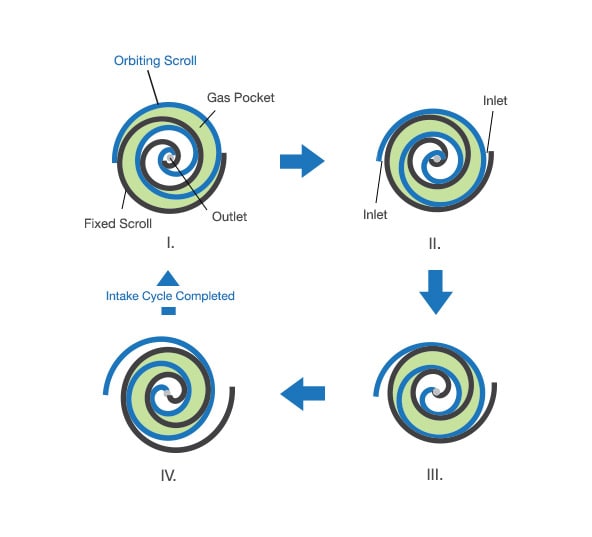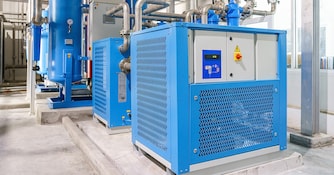
Scroll Compressor Buyer's Guide
Although the idea for a scroll compressor has been around for over 100 years, the technology is only about 50 years old. As the industry continues to advance, so does the need for reliable, clean, and oil-free compressed air. Scroll compressors are ideal in commercial applications that include: medical, pharmaceutical, food, laboratory, textile, electronics, and production facilities.
Anywhere quiet, clean air is required, a heavy-duty scroll compressor is the only way to go. They come in a wide variety of sizes, up to 40 HP, and can produce as much as 116 CFM! Scroll compressors utilize a very innovative (spiral) design that compresses air quietly with fewer moving parts and less required maintenance.
How Does a Scroll Compressor Work?
Scroll air compressors use two spiral-shaped scroll pieces to compress air. One scroll is stationary, meaning it's fixed in place and doesn't move, and the other fits inside the stationary scroll and is moved in a tight circular motion without rotating. The moving scroll presses against the inside of the stationary scroll in such a way that, as it moves in a circular motion, it pushes and traps air into small pockets between the two.
The pockets of air continue being moved through the spiral toward the center. As the air moves further toward the center of the spirals, the air pockets become smaller, and the air in those pockets gets compressed.

Once the compressed air pockets reach the center, they're released into a discharge pipe to be used, or they're released into an air treatment system. An air treatment system is not included with the scroll compressor, as it's typically custom-created with the necessary components to serve the user's desired purpose.
The air treatment system utilizes air delivery piping to deliver the compressed air from the compressor, through a series of filters and dryers, into a receiver tank where the air can be held until it's used. However, some applications that make constant use of the compressed air to run assembly-line machinery may not require a tank.
Key Benefits of Scroll Compressors
1. 100% Oil-Free Air
A major key benefit of scroll compressors is that they're 100% oil-free. For tasks or work environments that require 100% oil-free compressed air, scroll compressors can offer that. The two spirals found in scroll compressors that compress the air don't touch, meaning there's no need to use any oil for lubrication. But this doesn't just mean oil-free air, it also means there are no oil changes.
2. Very Low Maintenance
That leads to the next major benefit of scroll compressors—they're very low maintenance. Because there's no oil to change, and there are no spark plugs to worry about, the only real maintenance these machines require is a filter change. This not only saves you time, but it also saves you money. You don't have to worry about changing out oil filters, and you won't experience the costly pressure drop across oil filters.
3. Incredibly Energy Efficient
And speaking of saving money, scroll air compressors are incredibly energy efficient. In addition to the innovative scroll technology and lack of oil filters previously mentioned, these machines are also available with an optional built-in dryer that significantly reduces downstream pressure drop.
And if you're using your scroll air compressor for heavy-duty applications, there's an optional air-cooled IP55 class F motor designed specifically for the tough jobs. Furthermore, they're typically designed for easy serviceability, saving your more time and labor costs. So even if you weren't in need of an oil-free air compressor, the efficiency alone may be worth opting for a scroll compressor.
4. Extremely Quiet
Last, but not least, it's important to point out that these machines are extremely quiet during operation. The fact that there's no friction between the parts reduces noise significantly, as does the fact that there are no reciprocating pistons - keeping motion more smooth and balanced to reduce vibration.
Choosing the Right Scroll Compressor
When choosing a scroll compressor, first determine which type of electrical service you have, either single or 3-phase power. Single-phase is the standard type of service, while 3-phase power is a special commercial power service. If you have access to 3-phase power, you can benefit greatly from the high-efficiency premium motors that are available in those models.
Next, consider the varying specs. How much pressure do you need? Scroll compressors generally come in 116 PSI or 145 PSI, and both single-phase models and three-phase models come available in either one. Cubic feet per minute (CFM) is another spec you should consider when selecting a scroll compressor.
CFM is the amount of high-pressure air being released per minute. This is how much work your compressor can do per minute given a set PSI. So, a 116 PSI unit that puts out 55.1 CFM will be capable of completing tasks faster than a 116 PSI unit that puts out 8.9 CFM. Don't forget the optional built-in dryer for reducing pressure drop.
If you'll be using your new scroll air compressor for heavy-duty operation, you can also consider the optional air-cooled IP55 class F motor, which is totally enclosed and highly efficient.





